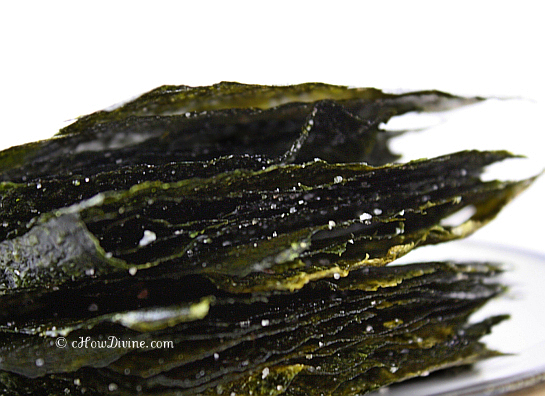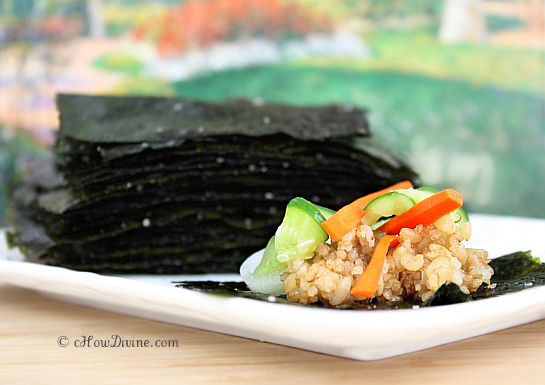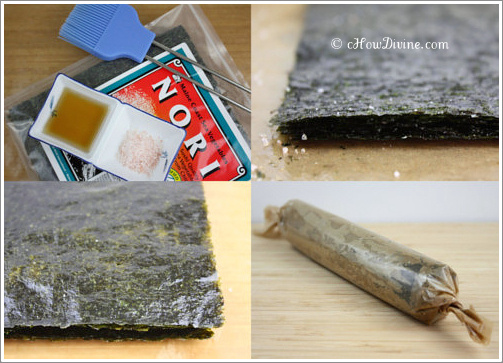Definition of GIM: Laver or Dried Seaweed (Nori in Japanese)
Ever since Trader Joe’s came in to New York City, I see people eating those toasted seaweed snacks everywhere. I get them occasionally, but I usually just make them at home. I like them right off the heat – super crispy and warm. That how I’ve always eaten them.
Growing up, my grandmother made these seaweed snacks (simply known as “gim” in Korea) at least 2-3 times a week. I remember her brushing oil and sprinkling salt on dried seaweed. She would then roll them up and wrap them tightly with aluminum foil until she was ready to toast them over fire. Even with the prepackaged seaweed snacks readily available in stores, she would always make them at home. She was adamant that fried foods or foods cooked in oil should be consumed right away – not packaged for shipping! My grandmother was a smart cookie. Heat does accelerate the rancidity of oils after all!
Besides, these seaweed snacks are very easy to make. I love Trader Joe’s as much as (or even more than) the next person, but the homemade stuff is so much better in taste and in health. You can use as much or as little oil and salt as you’d like. And you can experiment with different types of oils and salts. I usually use 1:1 ratio of canola and sesame oil. But you can just use canola oil or sesame oil alone. Grapeseed oil can be used in place of canola oil as well. And I almost always use pink Himalayan salt.
Additionally, you can use different types of cooking methods. You can toast them directly over medium heat/fire (I don’t recommend this unless you are an expert or own a nice flat grilling basket with a handle). You can toast them in a pan. Or you can roast them in the oven. Whichever method you choose, they will taste delicious. Simply enjoy them as a snack or enjoy them as a part of a wrap. Personally, I love wrapping some brown rice and pickled vegetables with them. So yummy!
Toasted (or Roasted) Seaweed Snacks Recipe
Ingredients
8 sheets gim (laver, dried seaweed, or nori)
1 TB canola oil
1 TB sesame oil
sea salt
- Stir together canola oil and sesame oil in a small bowl. Place one sheet of laver on parchment paper or aluminum foil. Brush the laver lightly with oil with a basting brush. Salt the laver lightly. Place the second laver ON TOP OF the first laver. Repeat with oil and salt. Repeat with rest of the laver.
- Roll up the laver sheets. Wrap them up tightly in parchment or aluminum foil until you’re ready to toast them (15 minutes – 1 hour). This will allow the laver to “marinate,” allowing the oil and salt to absorb evenly.
- Heat a large pan over medium heat. Once heated, place one sheet of laver on the pan. Allow the bottom side to toast until it turns a greenish hue. Turn over the laver using a spatula or tongs once the first side is toasted and allow the other side to toast. Once laver is crisp and toasted on both sides, take it out of the pan. Repeat with rest of the laver. *
- Once toasted, stack them on top of one another and cut into rectangles (or other shape you choose) using a sharp knife or kitchen shears.
*Cook’s Note:
On medium heat, it should take about 45 seconds – 1 minute per side. On low heat (not simmer), it should take about 1 minute – 1 1/2 minutes per side. However, this is just a guideline as stove top temperatures may vary.
You can also roast them in seconds directly over medium heat/fire (my grammy’s method, and probably the best :-)), if you have a flat grilling basket with a handle. Alternatively, you can roast the seaweed in the oven for about 15 minutes (depending on the oven) at 250-275 degrees. If you are roasting them in the oven, you can cut the seaweed into smaller pieces before you put them in the oven. You can flip them over after about 5-7 minutes, but you don’t need to flip them if you are using a baking rack.
Additionally, you are oiling and salting ONLY ONE SIDE of the laver! The oil and salt will distribute evenly on both sides by the virtue of the method in preparation.





I love seaweed snacks! I buy them all the time, but yes I’ve thought about making my own… yours look so very good!
I hope you give these a try. It will become easier and easier every time you make them. In no time, you’ll be able to make them in your sleep!
These were not snacks, but part of a meal I had almost everyday as a child. It was actually kind of funny when a non-Korean friend told me (years ago) that they were like the healthy potato chips! 🙂
These look so delicious. I didn’t know you could toast them. My son and I take some right out of the package and munch on them as snacks. I’ll bet they would taste so good toasted in the oven. thank you.
They are really yummy warm. You should try wrapping a little bit of brown rice with them as well. Healthy and so good!
Gomo, you are amazing. I think i’m in love 🙂
Awww, thanks for being so sweet. You so made my day Ken!!! 😀
Ha! As soon as I saw the title, I thought, like the seaweed snack at Trader Joe’s! I love those! Although, I have to admit, that it only take me about 5 minutes to eat half the box. Making your own sounds like a much better way to go!
One of the reasons why I make my own – other than the taste – is that I can go through them very quickly! So when I make my own, I use less salt. That way I won’t be drinking water all night! 🙂
I can’t tell how much I want to just jump up and go buy some seaweed and makes these. These must be really, really tasty with the sesame oil and salt infused into the seaweed! What a absolutely fabulous snack!
They do make a really fabulous snack. So addictive! It’s nice making them at home. It’s a treat eating them right off the stovetop or the oven!
Yay, love seaweed snacks! Never thought about making it though but this doesn’t look too difficult… hope to give it a try when I have the time 🙂 Thanks for sharing!
Hey Ames! Not difficult at all. Give it a try!
Hello 🙂 Can the roasted seaweed be made from rinsed and soaked salt packed Miyeok? It is what I have on hand, and I often make Wakame Salad, but I’m in the mood for some ‘chips’! Thanks so much for all of the delicious info you give!
Hi Bethany! Unfortunately, wakame/miyeok isn’t suitable for this. You need the flat rectangular seaweed or “gim” for this. I wouldn’t want you to waste your miyeok roasting it. 🙂
thank you so much! I will follow the provided instructions 🙂
You’re welcome! Another thing, I think you’ll be able to get “gim” at a lower price at Korean markets, rather than at a specialty store.
help! I was given 2 packs of toasted sea weed. Do your directions start with raw sea weed? If so how do I modify for pre-toasted
John
Hi John! I’ve used both types – toasted and not toasted – to make this. They both toast (or re-toast) so quickly, it shouldn’t make that much of a difference in preparation. You can basically follow the instructions as is. But if it is already toasted, I’m guessing it already has a greenish hue. If it does, that would not be a good indicator of doneness. But if you do this on the stovetop, you will see the seaweed shrink up a bit as it is being heated (as the moisture is sucked up). Turn over the seaweed once it starts to shrink, and heat for few more seconds. You can do this directly over heat if you have one of those flat grilling baskets. If not, you can use a pan. The seaweed will become crispy once it’s done.
Undoubtedly, you will get better results with Korean gim (seaweed). They are usually thinner and not toasted. They crisp up amazingly well. But the nori you have will be tasty nonetheless. 🙂
15 minutes in the oven?? Wouldn’t that reduce the nori to smudges of carbon on the cooking sheet?
I have tried it out, and I did not have them in that long!
I also used pumpkin seed oil, since I did not happen to have sesame oil, that was also tasty! 🙂
Hey GHN! It would depend on the oven I guess. 🙂 My oven at 250 degrees is like on dehydration mode! But I’m so glad you tried this out and liked it. Pumpkin seed oil, huh? I’ve never tried it before. Now you have me intrigued!
Hi, I love the seaweed from Trader Joes as well, but if you read the ingredients it appears to be an unhealthy snack seeing as though it is nearly 70% fat (divide calories from fat by grams of fat). Bummer! Make me feel better about eating them please. 🙂
Tony
Surely Tony! For the sake of full disclosure, I haven’t had the TJ’s seaweed snack in ages; so I don’t know the exact ingredients. But you have to take into account that seaweed is a VERY healthy, low-calorie food. A large rectangular sheet of seaweed is only about 8 calories, which means cut into 8 pieces (about the size of each sheet of TJ’s snacks), the calorie count comes to about 1 calorie/piece. So if you are putting any type of fat on it, whether it be healthy or unhealthy, it will make up the bulk – probably majority – of the calories. Even if the fat calorie only comes to about 2 or 3 calories per piece, mathematically, it will be ~70% of the calories.
What I’m trying to say is, in this case, you can’t just look at the calories in a vacuum – but in totality of the situation. Look at the ingredients. If they are using healthy fats, I would have no qualms about eating them. But of course, I make my own. It’s healthier, and you have total control over what you put on the seaweed. Hope this helps Tony! 🙂
I’m SO very thankful that you posted this. Seaweed snacks are so addicting, and I’ve been craving them for a long time, but they are WAAAAY too expensive to buy pre-made. So thank you for providing me with a cheaper, healthier way to make these wonderful bites of joy!
Thank you for your comment Melissa! I’m so happy you found it helpful. And I’m glad you mentioned the price of seaweed snacks. They are TOO expensive – especially for the teeny amount they give you in the package!
I hope you are having a wonderful week and have a great (long) weekend! 🙂
thank you, thank you so much.
you saved me from Bankruptcy.
since I discovered this delicious snack I became an addict
now I can get high on my own supply
🙂
You’re so welcome! I’m glad I can be of any help in keeping you solvent. 😀 It’s always better to be your own supplier when you need a fix, right? They are so expensive!
Hope you had a lovely weekend!
So glad I came across this! I had several sheets of nori leftover from maki sushi and was thinking about toasting them with salt but didn’t have the know-how to experiment, and now I do!
Question for you, when using the oven method, do you leave the sheets of nori stacked on one another or as separate sheets?
Hi Taylor, thanks for coming by the site! I’m glad you found the information useful. If you are using an oven, lay them out separately in a single layer. And you can cut them before putting them in the oven. Additionally, check for doneness/crispness at about 5-7 minutes. I find that ovens vary in strength esp in the lower temperatures. I hope you enjoy them! 😀
hello! how can I maintain the crispiness of nori when I pack them and how long will it last?
Hi Hazel! We usually put it in an Air-Tight container or bag and store it in the Freezer. I don’t think we ever stored it past 2-3 days, because we usually finished it by then. 🙂 It would also depend on the humidity level. But if you feel that they absorbed moisture and have become limp, you can simply toast it for a few seconds over fire/pan or a few minutes in the oven.
I hope this helps. Have a lovely rest of the weekend!
Hello,
As the beginner, I am confused some Korean seaweeds, could you please explain to me some differences between products?
(1), I tried the snack seaweed: toasted season, there are sesame oil, salty, crispy, very thin like very small paper, easy to carry in a small box packaged. I can digest well. Quite tasty. Good choice!
(2), The second season seaweed: crispy, not so salty, no oil:
not as tasty as the (1).
(3), The roasted sea-laver ‘A+ Roasted Sea Laver For Sushi’: it’s so big like a big paper,…. thicker than (1) and (2) so heavy for my stomach, and I can not digest well, no taste!
Can you explain to me the big differences of seaweed and sea laver? I see they look same color, but different sizes, thicker and thinner, why the (1) I can digest well, while the (3) can not digest well. Both I make soup.
I have some problem in eating for my stomach, I can not eat meat nor fish, so to get some protein, I am trying seaweed. Could you please help me to give me some advices? Thank you a lot. My.
Hi My, thanks for dropping by the site. I’m not a doctor or a nutritionist, so I can’t really address the digestive issues. But I will say that the rectangular or square seaweed that is sold in Korean markets are basically the same things. The thin ones are used to make the snacks that they sell in the packages, or toasted and crushed for garnishes. The snacks that they sell already seasoned are oiled, salted, and toasted and, often times, cut up before packaging. And the thick ones are for making Gimbap or Sushi. The thick ones come toasted sometimes. The difference is in the thickness. And if anything, the snacks should be more difficult to digest since oil and salt have been added to the seaweed.
Additionally, these sheets of seaweed are not what is used for soups. Instead, miyeok is used for Korean seaweed soups. Miyeok is not flattened into sheets. And you’d normally soak them before using them in soups.
I don’t eat a lot of meat either. But from my situation and experience as a limited-meat-eater, it isn’t practical for you to get most of your protein from seaweed. There’s only so much seaweed you can eat. Have you tried eating beans (assuming you can digest them)? Soak them in a little kombu (kelp) before cooking. That should make them a bit more digestible. But if you have considerable digestive issues, you really should see a doctor to determine the cause.
I hope this helps.
I’m making a travel pack for my boyfriend and I wanted to include healthy snacks that don’t need refrigeration. These are perfect because we both love those seaweed snacks and this saves money. 🙂
These make great healthy snacks! Just make sure you keep them really dry to keep them crisp. I’m so glad you found the recipe useful. Hope you and your boyfriend enjoy them!
I usually get fresh nori from the ocean do you know how to dry it in sheets? ive tried putting it on a sheet and baking it but it doesn’t taste that great.. probably better if its dried first..
Hi Eric, drying into sheets is not something you can do at home. Just baking them in the oven will not yield the same results – in taste or in appearance. Dried nori sheets are readily available in stores. You can always use the fresh ones in salads or soups. Hope this helps!
My brother goes through the Annie Chun’s seaweed snacks like it’s his job, so I’d love to make him some. Do you know if I could add flavors to these seaweed snacks? Like, if I wanted to add a touch of wasabi, would that be possible? If so, when in the cooking process would I do that?
Hi Meredith! Sorry about the late response. My expected short break became an unexpected sabbatical of sorts.
One of my uncles is the same way. He goes through seaweed snacks like crazy! I never tried putting wasabi on seaweed snacks. But I do know that the wasabi powder needs to be mixed in with warm water and worked into a paste for the potency to come out (unless you’re buying the paste in a tube). I guess you can try mixing a tiny bit in with the oil and brushing the mixture on the seaweed. -OR- If you just want to add some wasabi powder, you can mix a tiny bit in with the salt. They will adhere to the oil that’s been applied to the seaweed. If you try to do it after the seaweed has been toasted, I would expected it to be messier. You wouldn’t want wasabi powder getting on/in other dishes or surfaces.:) Hope your new year has been a good one!
I love wasabi and I love roasted laver. To get a great wasabi flavor, I don’t use wasabi powder, but simply drizzle a bit of wasabi oil on the roasted sheets (only a few drops on each sheet). I imagine one could substitute wasabi oil in place of the other oils (i.e. sesame oil) before roasting, but I haven’t tried it.
I didn’t even realize there was wasabi oil! Good to know. Thanks for the info Drew.
Do you have to use sesame seed oil? Could you use coconut oil or sunflower oil or olive oil?
Hi Lorna~ Sesame oil mixed in with a neutral oil will give it the traditional nutty taste. If you don’t want to use or do not have dark sesame oil, you can just use a neutral oil, like canola or grapeseed oil. I think sunflower oil has a neutral taste right? Olive or coconut oil has a distinct flavor (esp. coconut). So I wouldn’t use coconut oil; but if you really want to use olive oil, mix it in some neutral-tasting oil. I hope this helps.
I would buy little boxes of these snacks from Trader Joe’s, at 11.3g, for $.99. I stopped into an Asian market, and found 20g envelopes (5 BIG sheets of seasoned/salted laver in an envelop), bundled together in fours (80g total), selling for $4. I stopped buying these at TJ’s and started paying a lot less for my treat. You describe MAKING these, which I think wold be more inexpensive still, but the instructions say to start with 8 sheets of gim. I think of that as the end product. Am I just having a vocabulary problem?
Hi acorben! Each sheet of gim (nori) would yield about 6-8 smaller pieces once cut into TJ’s-sized snacks. So 8 sheets of gim would yield 56-64 pieces. You can make less or more; 8 was just a random number. My grandmother used to make much more than that for my family just for dinner! I like to make a few sheets at a time and eat them while still warm and toasted. If you decide to store the uneaten portion, make sure to put it in an airtight container or ziploc and in the freezer. They should stay fresh for a few days.
BTW, you may be able to find untoasted, raw, dried “gim” at a cheaper price at a Korean market. These are the best for make these snacks as they are thinner. They end up super light and crispy when prepared. I hope this helps!
Love this recipe! I just made a double batch and they are sooo addicting, my boyfriend would have eaten them all in one sitting if I hadn’t cut him off. Thanks so much for sharing, hope it is okay for me to post the recipe on my site 🙂
Hi Lara,
We have the same problems here at our home too. My husband will finish whatever size batch I make if I don’t stop him, so I just make smaller batches now. 🙂 You are welcome to use the photo with credit and link back to this page, but please don’t post the recipe in its entirety. Thanks for coming by the site.
I just found this recipe and am an absolute lover of nori and seaweed snacks. This looks so easy and much for financially feasible. Gomo, you are brilliant and I will be following you for other wonderful, healthy alternative recipes. Thank you for
Thanks so much for your encouraging words Pam!